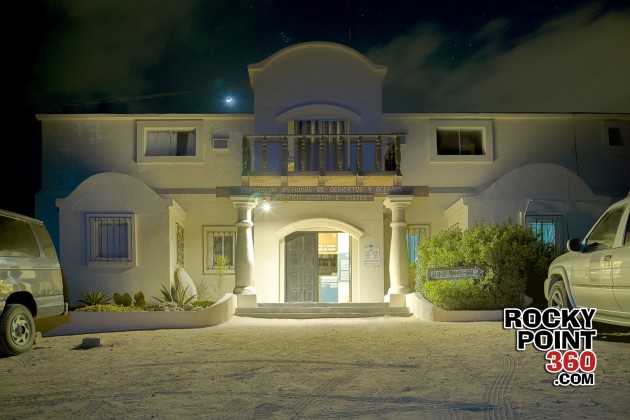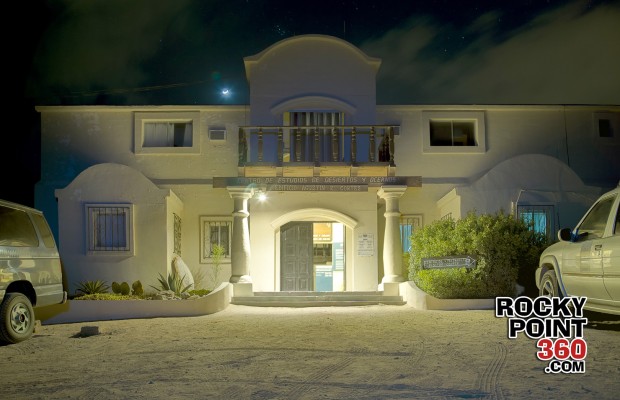 Moonless tidepool adventure
Moonless tidepool adventure
[excerpts from Spanish original text]
It sounds romantic, doesn’t it? A stroll on the beach at night, with nothing but water at your feet, a headlamp and a small blue net to explore the rocky reef that we know as the Mirador.
This is one of the activities I have seen announced on various occasions but for one reason or another I hadn’t decided to call up and reserve. Until now. …
This is one of the varied activities CEDO offers, and one I was drawn to in being at night while offering the chance to learn more about the sea and its secrets. I could possibly walk through the area alone (I had thought), but I probably wouldn’t see much as I wouldn’t know where to look. So, if you go with someone who knows where to search, even better, opening both your eyes and curiosity.
Everything begins at CEDO when you first arrive. After greeting the whale skeleton, participants sign a waiver (not so much because the trip is dangerous, it’s just a precaution). On this occasion, we were welcomed by the smile of Abraham Meza who told us the introductory chat would take place right there, in the seating area. We were just three couples in all, so there was no problem in finding a place to sit.
CEDO, given its initials in Spanish, is the Centro Intercultural de Estudios de Desierto y Oceános, having first opened its doors in Las Conchas in 1980. Abraham also explains CEDO’s mission from the beginning has been to help, empower, and work with coastal communities in the Northern Gulf of California region in order to create sustainable environments in line with the natural surroundings (such as, for example, the current MIA program working with regional fishermen). With this in mind, CEDO is in constant movement, developing and implementing programs as well as scientific, cultural, and environmental materials that stimulate and encourage a multicultural community. This extends to residents, visitors, students, as well as scientists and organizations, environmental centers and biological reserves with whom CEDO works in areas of awareness, conservation, and ecology.
Puerto Peñasco is in privileged and protected area, one which is full of life and unique surprises that are simply not found everywhere, such as, for example, the tides.
What causes tides? The common answer: the moon. The not so common answer: the sun. Certainly these changes are produced thanks to gravitational forces, but how? Abraham asked for three volunteers to help explain.
“Who would like to be the Sun?” he asks. A woman raises her hand. “Ok, so there’s no problem with you,” – he points to a young girl – “being the Earth, and you,” – he points to her companion, “– the Moon?” They seem to be fine with it. “Ok, everyone form a line, Sun and Moon – each take one of the Earth’s hands and pull.”
“See? The pull is direct and strong,” Abraham explains, “Now, Moon, take a few steps back, and both of you pull again. Do you see how the force isn’t the same? That’s what happens with the tides.”
“When the Sun and Moon are aligned with the Earth, the tides are more drastic and there is a tremendous difference in how they rise and fall. However, when each of them are on their own side, the tides are much softer. In fact, if we look at a tide calendar (which, by the way, are on sale at CEDO’s gift shop), we can observe this phenomenon. There are days when the differences are very pronounced, and others that are very subtle. This has to do with the full and new moon.”
“However, this is not the same everywhere,” he goes on, “In fact, this region competes with Canada as the second spot in the world with the most extreme tides. The first is somewhere in France, I believe. This is because the Sea of Cortez is not an open sea; it is very narrow and not very deep. So, when the tide goes out, it filters into deeper areas at greater distances.”
“You may ask, what does this have to do with tidepools?” Abraham continues, “Thanks to these drastic movements, when the tide goes out along the rocky reef where we are going to go – which many know as the Mirador – small pools form. As we go along areas that would normally be covered by water, we can see more and more organisms living in this area.”
“There are just a few rules before we go on,” stated Abraham, “One: if you see something red, don’t touch it, normally these are poisonous or irritating organisms. Two: We can only take away three things: sand (in your shoes) – photos (memories) – and your trash.”
When we got to the beach, we were given headlamps and small, blue nets – like from an aquarium. It looked fun. This, undoubtedly, was a clue we were not going to see anything huge in the water. We were “hunting” bugs, small, interesting and intriguing organisms that survive within the small pools of salt water that remain when the tide goes out. …
One must have an open mind, because what can be found in these spots is absolutely fascinating. It is the basis of a complex ecosystem, one where there are small, living, strange beings with very different manners of existence.
To begin with, nothing is in plain site; we need to readjust our “search criteria”, to put it one way, which is why it’s important to listen to the biologist, in this case Abraham, who showed us where everything was hidden.”
“Do you see these little feet sticking out from under than rock, like worms? That’s an Echinodermathas species, very similar to starfish,” He pulls it out and shows us, delicate and fragile. “If you want to touch it, first wet your hands.” And so he went on, as we advanced, “These hairs? Anemone. These others? Sea cucumbers. See that rock? Crab. Look – these algae have little bags that fill up with air so that when the water rises, they can float and be closer to the sun.”
I looked up (and my headlamp lit up the area in front of me), and what before had been rocks had become small worlds to be discovered. Now, to look for what brushes against our feet when out swimming in the area. ….
We spent around two hours like this, with our headlamps lighting up various spots at the same time. We found crab, bald solitary anemone (they’re not called that, but that’s how I remember them), sea cucumbers, sea life. Abraham showed us small plants with branches in form of bird feathers, which irritate the skin. Careful, because you can hardly even seem them. In other pools there were small fish and little shrimp, whose eyes glistened despite being nearly transparent and hidden under brush and algae. …
On the way back to the van, I fixed my eye on a small pool where a shy fish swam; suddenly, I saw something long, something that was neither stone nor plant. As I touched it delicately (I believed) with my net, it seemed to stretch out further along the rock. I called Abraham over, as I didn’t know what it was, we could only see a green part with a black strip next to the rock. “I believe I know what it is,” he said, sticking his hand down and, with some work, pulling it out. It was a starfish! Large and strange, and hard. I always thought they were watery or slimy, given their grace as shown in documentaries. ….
We returned to the van, where we turned back in our headlamps and nets, and I returned sand from my tennis shoes to the beach. As we headed toward CEDO, Abraham told us there were people who during low tides would gather up shells and hermit crabs in order to sell them for aquariums. It’s a sad case; nevertheless, he told us not to judge as these people had found a way to sustain themselves and so no one was free of guilt, when we buy these for an aquarium we are promoting this type of practice. On the other hand, alternatives need to be sought for people. It’s not enough to point out a problem (which is a good first step), but rather to propose solutions, which is what CEDO tries to do.
Check with CEDO for upcoming adventures. All tours begin and end at CEDO’s field station in Puerto Peñasco, Sonora. Reservations can be made by phone at (520) 320-5473 in the U.S. or 011-526-38-382-0113, or 0115, in Mexico, or by email at info@cedointercultural.org. Reservations should be made at least two days prior to the event.
